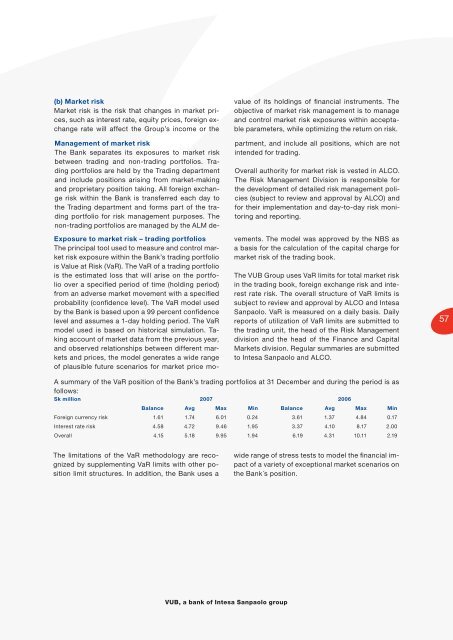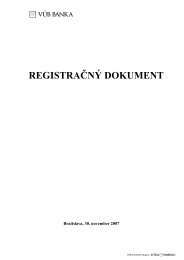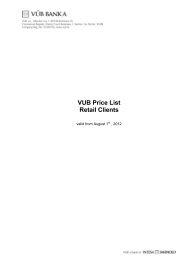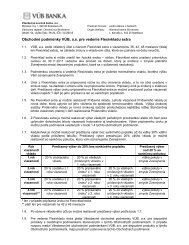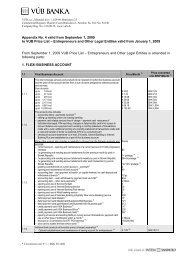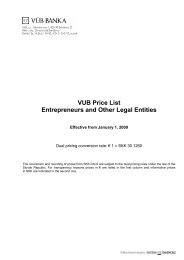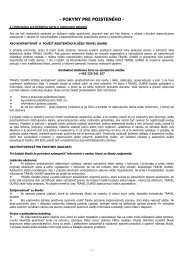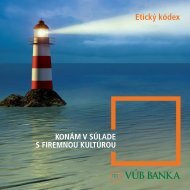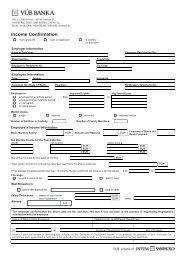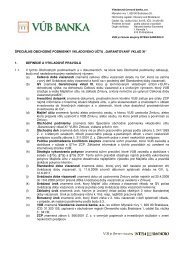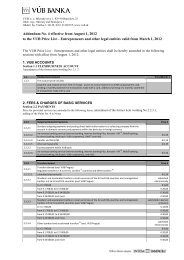Annual Report - VÃB banka
Annual Report - VÃB banka
Annual Report - VÃB banka
You also want an ePaper? Increase the reach of your titles
YUMPU automatically turns print PDFs into web optimized ePapers that Google loves.
(b) Market risk<br />
Market risk is the risk that changes in market prices,<br />
such as interest rate, equity prices, foreign exchange<br />
rate will affect the Group’s income or the<br />
value of its holdings of fi nancial instruments. The<br />
objective of market risk management is to manage<br />
and control market risk exposures within acceptable<br />
parameters, while optimizing the return on risk.<br />
Management of market risk<br />
The Bank separates its exposures to market risk<br />
between trading and non-trading portfolios. Trading<br />
portfolios are held by the Trading department<br />
and include positions arising from market-making<br />
and proprietary position taking. All foreign exchange<br />
risk within the Bank is transferred each day to<br />
the Trading department and forms part of the trading<br />
portfolio for risk management purposes. The<br />
non-trading portfolios are managed by the ALM department,<br />
and include all positions, which are not<br />
intended for trading.<br />
Overall authority for market risk is vested in ALCO.<br />
The Risk Management Division is responsible for<br />
the development of detailed risk management policies<br />
(subject to review and approval by ALCO) and<br />
for their implementation and day-to-day risk monitoring<br />
and reporting.<br />
Exposure to market risk – trading portfolios<br />
The principal tool used to measure and control market<br />
risk exposure within the Bank’s trading portfolio<br />
is Value at Risk (VaR). The VaR of a trading portfolio<br />
is the estimated loss that will arise on the portfolio<br />
over a specifi ed period of time (holding period)<br />
from an adverse market movement with a specifi ed<br />
probability (confi dence level). The VaR model used<br />
by the Bank is based upon a 99 percent confi dence<br />
level and assumes a 1-day holding period. The VaR<br />
model used is based on historical simulation. Taking<br />
account of market data from the previous year,<br />
and observed relationships between different markets<br />
and prices, the model generates a wide range<br />
of plausible future scenarios for market price movements.<br />
The model was approved by the NBS as<br />
a basis for the calculation of the capital charge for<br />
market risk of the trading book.<br />
The VUB Group uses VaR limits for total market risk<br />
in the trading book, foreign exchange risk and interest<br />
rate risk. The overall structure of VaR limits is<br />
subject to review and approval by ALCO and Intesa<br />
Sanpaolo. VaR is measured on a daily basis. Daily<br />
reports of utilization of VaR limits are submitted to<br />
the trading unit, the head of the Risk Management<br />
division and the head of the Finance and Capital<br />
Markets division. Regular summaries are submitted<br />
to Intesa Sanpaolo and ALCO.<br />
57<br />
A summary of the VaR position of the Bank’s trading portfolios at 31 December and during the period is as<br />
follows:<br />
Sk million 2007 2006<br />
Balance Avg Max Min Balance Avg Max Min<br />
Foreign currency risk 1.61 1.74 6.01 0.24 3.61 1.37 4.84 0.17<br />
Interest rate risk 4.58 4.72 9.46 1.95 3.37 4.10 8.17 2.00<br />
Overall 4.15 5.18 9.95 1.94 6.19 4.31 10.11 2.19<br />
The limitations of the VaR methodology are recognized<br />
by supplementing VaR limits with other position<br />
limit structures. In addition, the Bank uses a<br />
wide range of stress tests to model the fi nancial impact<br />
of a variety of exceptional market scenarios on<br />
the Bank´s position.<br />
VUB, a bank of Intesa Sanpaolo group


